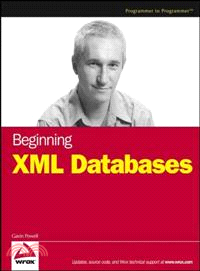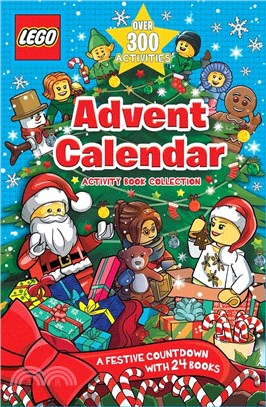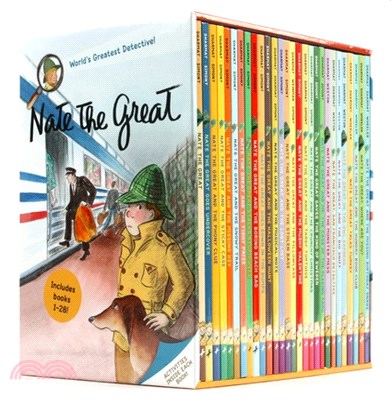BEGINNING XML DATABASES
商品資訊
ISBN13:9780471791201
出版社:JOHN WILEY & SONS;LTD
作者:POWELL
出版日:2006/10/27
裝訂/頁數:平裝/470頁
商品簡介
作者簡介
名人/編輯推薦
目次
相關商品
商品簡介
Supported by all major database systems, XML provides an easy, standardized method of transferring data between databases and to and from the Web, independent of the software in use
Offers database programmers and data-driven Web developers detailed guidance on how to understand and work with XML as data
Numerous hands-on, step-by-step examples help readers learn to simplify database work using XML
Shows how to use XML to exchange data between multiple databases either internally or with external customers and partners
Covers XML in popular databases including Oracle Database, SQL Server, and brief coverage of DB2 Database
Covers basic syntax for XML, the XML DOM, and XSL – with an emphasis on database use, and native XML databases
Additional topics covered include Native XML databases, XPath, XQuery, XLink, XPointer, DTDs, XML Schemas, among others
Offers database programmers and data-driven Web developers detailed guidance on how to understand and work with XML as data
Numerous hands-on, step-by-step examples help readers learn to simplify database work using XML
Shows how to use XML to exchange data between multiple databases either internally or with external customers and partners
Covers XML in popular databases including Oracle Database, SQL Server, and brief coverage of DB2 Database
Covers basic syntax for XML, the XML DOM, and XSL – with an emphasis on database use, and native XML databases
Additional topics covered include Native XML databases, XPath, XQuery, XLink, XPointer, DTDs, XML Schemas, among others
作者簡介
Gavin Powell has a BSc. in Computer Science, along with numerous professional accreditations and skills. He has had a lot of practice with things like XML, Oracle, Ingres, and MSAccess, as well as a multitude of application development languages and platforms. He has almost 20 years of contracting, consulting, and hands-on educating experience—in both software development and database administration roles. He has lived, studied, and worked on three different continents, and is now scratching a living as a writer, musician, and family man. He can be contacted at creativemusician@bellsouth.net or info@oracledbaexpert.com.
名人/編輯推薦
“The book can be used as a very good introductory text for students and practitioners eager to acquire knowledge...” (Zentralblatt MATH, Vol. 1118 2007/20)
目次
Introduction.
Chapter 1: What Is XML?
Comparing HTML and XML.
What Is XML Capable Of?
What Is XSL?
Creating and Displaying a Simple XML Document.
Embedding XML in HTML Pages (Data Islands).
Introducing the XML Document Object Model.
XML Browsers and Different Internet Browsers.
The Document Type Definition.
XML Syntax.
Elements.
Attributes.
Reserved Characters in XML.
Ignoring the XML Parser with CDATA.
What Are XML Namespaces?
XML in Many Languages.
Summary.
Exercises.
Chapter 2: The XML Document Object Model.
Basic XML DOM Structure.
The Primary XML DOM Classes.
The Node Class.
The Document Class.
The Element Class.
The Attr Class.
The Text Class.
More Obscure XML DOM Classes.
The parseError Class.
HTTPRequest Class.
Other Classes.
Generating XML Using ASP.
Summary.
Exercises.
Chapter 3: Extending the Power of XML with XSL.
What Is XSL?
The Roots of XSL.
Basic XSL Elements Syntax.
Processing Instruction Elements.
Transformation Elements.
Node Creation Elements.
Data Retrieval Elements.
Control Structure Elements.
Advanced XSL Syntax.
Function Versus Method.
XSL Function Syntax.
XSL Method Syntax.
XSL Pattern Matching Syntax.
Combining the XML DOM and XSL.
Summary.
Exercises.
Chapter 4: Relational Database Tables and XML.
Using SQL for Database Access.
Queries.
Changing Data in a Database.
Generating XML Pages Using Basic SQL.
Summary.
Exercises.
Chapter 5: Oracle Database and XML.
The Oracle XMLType Data Type.
Oracle XMLType Data Type Methods.
Implementing XML in an Oracle Database.
Creating XML Documents from an Oracle Database.
XML and the Database.
New XML Documents.
Retrieving from XML Documents.
Using XMLType Methods to Read XML Documents.
Changing and Removing XML Document Content.
Summary.
Exercises.
Chapter 6: SQL Server and XML.
The SQL Server XML Data Type.
SQL Server XML Data Type Methods.
Generating XML: The FOR XML Clause.
FOR XML RAW Mode.
FOR XML AUTO Mode.
FOR XML EXPLICIT Mode.
FOR XML PATH Mode.
Generating Tuples from XML: OPENXML.
Working with XML Data Types.
Adding XML Documents to SQL Server.
Retrieving and Modifying XML Data Types.
Defining XML Content with XSD Schemas.
Strongly Typing XML Documents with XSD.
Mapping an XSD Schema to a Table.
Annotating the XSD Script to Enforce Relationships.
Storing XSD as a Schema Collection.
Creating Indexes on XML Data Types.
Summary.
Exercises.
Chapter 7: XML in Heterogeneous Environments.
Basic XML Document Transfer.
Sharing XML with Web Services.
The HTTP Protocol.
Transformation Processing.
Web Services Protocol.
Applying Semantics to XML Transfers.
Simple Object Access Protocol.
External Data and XML.
B2B Data Transfer.
Summary.
Exercises.
Chapter 8: Understanding XML Documents as Objects.
Why Explain the Object Model Here?
XML Data as a Relational Structure.
The Basics of the Object Data Model.
Creating an Object Model from a Relational Model.
XML Data as an Object Structure.
Summary.
Exercises.
Chapter 9: What Is a Native XML Database?
An XML Document Is a Database.
Defining a Native XML Database.
Creating a Native XML Database.
Schema-Less Native XML Database Collections.
What Is Indexing?
What About Using XSL and the XML DOM?
Classify Native XML Databases by Content.
Document-Centric XML.
Data-Centric XML.
Using a Native XML Database.
Summary.
Exercises.
Chapter 10: Navigating XML Documents Using XPath.
What Is XPath?
Absolute and Relative Paths.
XPath Nodes.
XPath Node Relationships.
XPath Expression Syntax.
Simple Expressions to Find Nodes.
Find Specific Values Using Predicates.
Use Wildcards to Find Unknown Nodes.
Expressions on Multiple Paths.
XPath Axes.
XPath Functions.
Accessor Functions.
Errors and Tracing.
Constructor Functions.
Numeric Functions.
String Functions.
URI Functions.
Boolean Functions.
Functions on Durations, Dates, and Times.
QName Functions.
Node Functions.
Sequence Functions.
Context Functions.
Summary.
Exercises.
Chapter 11: Reading XML Documents Using XQuery.
What Is XQuery?
Shared Components.
The Basics of XQuery.
Executing XQuery Queries.
Embedding XQuery Code into HTML.
XQuery Terminology.
XQuery Syntax.
Functions in XQuery.
XQuery FLWOR.
FLWOR: The Basic for Loop and Return Clause.
FLWOR: Adding a where Clause.
FLWOR: Adding an Order By Clause.
FLWOR: Declaring Variables with the Let Clause.
FLWOR: Embedded for Loops and Communication.
XQuery in Oracle XML DB.
What Is XQueryX?
Summary.
Exercises.
Chapter 12: Some Advanced XML Standards.
XLink and XPointer.
What Is XLink?
Simple XLinks.
Extended XLinks.
What Is XPointer?
XForms and HTML Form Generation.
The XForms Model.
XForms Namespaces.
Other XForms Input Types.
Data Types in XForms.
Restricting Values with XForms Properties.
XForms Object Actions.
Built-in and User-Defined Functions.
Binding Data Using XPath.
Embedding XML Documents with XInclude.
Formatting XML Output Using XML-FO.
Summary.
Exercises.
Chapter 13: Data Modeling and XML.
The Document Type Definition.
DTD Elements.
DTD Attributes.
DTD Entities.
The XML Schema Definition.
Global and Local Types.
Basic XSD Structures.
Substitution.
Summary.
Exercises.
Chapter 14: Applying XML Databases in Industry.
What Can XML Do?
Managing Complex Data with XML.
Does Database Size Matter?
Are Schema Changes Easier with XML?
Native XML Databases.
Specific XML Vocabularies.
XML Vocabularies.
Commercial Implementation of XML.
When to Use a Native XML Database.
Summary.
Glossary.
Appendix A: Exercise Answers.
Appendix B: The Sample Database.
Appendix C: Syntax Conventions.
Appendix D: XML Technology.
Appendix E: XML Relational Database Technology.
Index.
Chapter 1: What Is XML?
Comparing HTML and XML.
What Is XML Capable Of?
What Is XSL?
Creating and Displaying a Simple XML Document.
Embedding XML in HTML Pages (Data Islands).
Introducing the XML Document Object Model.
XML Browsers and Different Internet Browsers.
The Document Type Definition.
XML Syntax.
Elements.
Attributes.
Reserved Characters in XML.
Ignoring the XML Parser with CDATA.
What Are XML Namespaces?
XML in Many Languages.
Summary.
Exercises.
Chapter 2: The XML Document Object Model.
Basic XML DOM Structure.
The Primary XML DOM Classes.
The Node Class.
The Document Class.
The Element Class.
The Attr Class.
The Text Class.
More Obscure XML DOM Classes.
The parseError Class.
HTTPRequest Class.
Other Classes.
Generating XML Using ASP.
Summary.
Exercises.
Chapter 3: Extending the Power of XML with XSL.
What Is XSL?
The Roots of XSL.
Basic XSL Elements Syntax.
Processing Instruction Elements.
Transformation Elements.
Node Creation Elements.
Data Retrieval Elements.
Control Structure Elements.
Advanced XSL Syntax.
Function Versus Method.
XSL Function Syntax.
XSL Method Syntax.
XSL Pattern Matching Syntax.
Combining the XML DOM and XSL.
Summary.
Exercises.
Chapter 4: Relational Database Tables and XML.
Using SQL for Database Access.
Queries.
Changing Data in a Database.
Generating XML Pages Using Basic SQL.
Summary.
Exercises.
Chapter 5: Oracle Database and XML.
The Oracle XMLType Data Type.
Oracle XMLType Data Type Methods.
Implementing XML in an Oracle Database.
Creating XML Documents from an Oracle Database.
XML and the Database.
New XML Documents.
Retrieving from XML Documents.
Using XMLType Methods to Read XML Documents.
Changing and Removing XML Document Content.
Summary.
Exercises.
Chapter 6: SQL Server and XML.
The SQL Server XML Data Type.
SQL Server XML Data Type Methods.
Generating XML: The FOR XML Clause.
FOR XML RAW Mode.
FOR XML AUTO Mode.
FOR XML EXPLICIT Mode.
FOR XML PATH Mode.
Generating Tuples from XML: OPENXML.
Working with XML Data Types.
Adding XML Documents to SQL Server.
Retrieving and Modifying XML Data Types.
Defining XML Content with XSD Schemas.
Strongly Typing XML Documents with XSD.
Mapping an XSD Schema to a Table.
Annotating the XSD Script to Enforce Relationships.
Storing XSD as a Schema Collection.
Creating Indexes on XML Data Types.
Summary.
Exercises.
Chapter 7: XML in Heterogeneous Environments.
Basic XML Document Transfer.
Sharing XML with Web Services.
The HTTP Protocol.
Transformation Processing.
Web Services Protocol.
Applying Semantics to XML Transfers.
Simple Object Access Protocol.
External Data and XML.
B2B Data Transfer.
Summary.
Exercises.
Chapter 8: Understanding XML Documents as Objects.
Why Explain the Object Model Here?
XML Data as a Relational Structure.
The Basics of the Object Data Model.
Creating an Object Model from a Relational Model.
XML Data as an Object Structure.
Summary.
Exercises.
Chapter 9: What Is a Native XML Database?
An XML Document Is a Database.
Defining a Native XML Database.
Creating a Native XML Database.
Schema-Less Native XML Database Collections.
What Is Indexing?
What About Using XSL and the XML DOM?
Classify Native XML Databases by Content.
Document-Centric XML.
Data-Centric XML.
Using a Native XML Database.
Summary.
Exercises.
Chapter 10: Navigating XML Documents Using XPath.
What Is XPath?
Absolute and Relative Paths.
XPath Nodes.
XPath Node Relationships.
XPath Expression Syntax.
Simple Expressions to Find Nodes.
Find Specific Values Using Predicates.
Use Wildcards to Find Unknown Nodes.
Expressions on Multiple Paths.
XPath Axes.
XPath Functions.
Accessor Functions.
Errors and Tracing.
Constructor Functions.
Numeric Functions.
String Functions.
URI Functions.
Boolean Functions.
Functions on Durations, Dates, and Times.
QName Functions.
Node Functions.
Sequence Functions.
Context Functions.
Summary.
Exercises.
Chapter 11: Reading XML Documents Using XQuery.
What Is XQuery?
Shared Components.
The Basics of XQuery.
Executing XQuery Queries.
Embedding XQuery Code into HTML.
XQuery Terminology.
XQuery Syntax.
Functions in XQuery.
XQuery FLWOR.
FLWOR: The Basic for Loop and Return Clause.
FLWOR: Adding a where Clause.
FLWOR: Adding an Order By Clause.
FLWOR: Declaring Variables with the Let Clause.
FLWOR: Embedded for Loops and Communication.
XQuery in Oracle XML DB.
What Is XQueryX?
Summary.
Exercises.
Chapter 12: Some Advanced XML Standards.
XLink and XPointer.
What Is XLink?
Simple XLinks.
Extended XLinks.
What Is XPointer?
XForms and HTML Form Generation.
The XForms Model.
XForms Namespaces.
Other XForms Input Types.
Data Types in XForms.
Restricting Values with XForms Properties.
XForms Object Actions.
Built-in and User-Defined Functions.
Binding Data Using XPath.
Embedding XML Documents with XInclude.
Formatting XML Output Using XML-FO.
Summary.
Exercises.
Chapter 13: Data Modeling and XML.
The Document Type Definition.
DTD Elements.
DTD Attributes.
DTD Entities.
The XML Schema Definition.
Global and Local Types.
Basic XSD Structures.
Substitution.
Summary.
Exercises.
Chapter 14: Applying XML Databases in Industry.
What Can XML Do?
Managing Complex Data with XML.
Does Database Size Matter?
Are Schema Changes Easier with XML?
Native XML Databases.
Specific XML Vocabularies.
XML Vocabularies.
Commercial Implementation of XML.
When to Use a Native XML Database.
Summary.
Glossary.
Appendix A: Exercise Answers.
Appendix B: The Sample Database.
Appendix C: Syntax Conventions.
Appendix D: XML Technology.
Appendix E: XML Relational Database Technology.
Index.
主題書展
更多
主題書展
更多書展今日66折
您曾經瀏覽過的商品
購物須知
外文書商品之書封,為出版社提供之樣本。實際出貨商品,以出版社所提供之現有版本為主。部份書籍,因出版社供應狀況特殊,匯率將依實際狀況做調整。
無庫存之商品,在您完成訂單程序之後,將以空運的方式為你下單調貨。為了縮短等待的時間,建議您將外文書與其他商品分開下單,以獲得最快的取貨速度,平均調貨時間為1~2個月。
為了保護您的權益,「三民網路書店」提供會員七日商品鑑賞期(收到商品為起始日)。
若要辦理退貨,請在商品鑑賞期內寄回,且商品必須是全新狀態與完整包裝(商品、附件、發票、隨貨贈品等)否則恕不接受退貨。
























